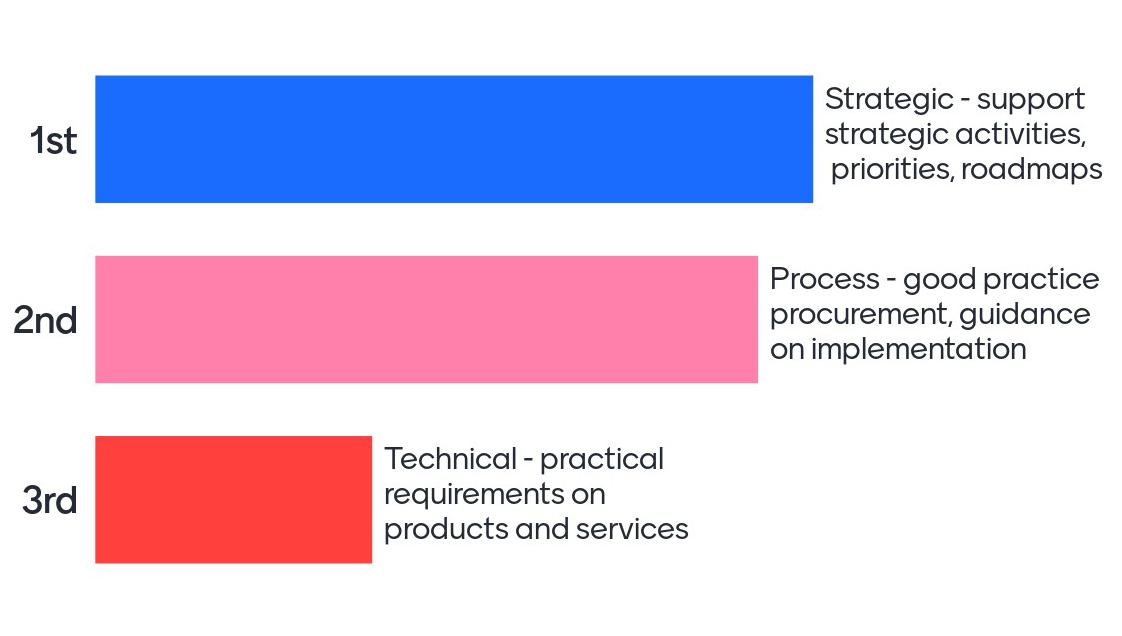
13 minute read
Reforms to meet Australia’s future
On policy, State governments are leading on action and investment in building DTw capability, platforms and use cases. Local government too is mobilising, with much focus around strategy and business case development.
At a national level, Infrastructure Australia has clearly identified ‘digital by default’ as the desired infrastructure norm, with clear actions and programmatic intent to enable DTw as a core opportunity for the sector.
Advertisement
In the private sector, practitioners are slowly retooling, and building on their foundational capability through legacy investments in GIS, BIM and broader digital engineering and planning skills and platforms.
On standards, ISO/IEC JTC 1/SC 41 has the role of growing standardisation in the area of Internet of Things and DTw, including their related technologies. And Australia has strong representation and participation in this international work.
Its focus is to create horizontal and flexible foundational standards such as those referenced in the previous section, around items such as terminology, maturity models, case studies and reference architecture.
5.2 Existing and Aligned Efforts
Building Information Modelling (BIM) is currently a growing influence on how major infrastructure and property projects are designed and assets managed. However the history of BIM is one that suffered slow and little uptake (and impact) in its early years, taking over a decade or more to gather momentum from the ‘demand side’. While for approximately 40 years the supply side has been innovating and primmed for action[i], the demand for BIM continues to be slow.
In 2018 the State of Queensland was the first government entity in the country to establish a whole of government BIM approach, requiring all major government projects to implement BIM by 2023[ii]. This was then followed by the Victoria[iii] and New South Wales[iv] governments who respectively published various digital engineering related frameworks.
The Australian BIM Advisory Board is also playing a strategic role in supporting the BIM community engage with the DTw agenda with its 2021 publication ‘DTws: An ABAB Position Paper’[v].
The geospatial sector has developed a leadership position with the DTw agenda through multiple international, national and state-based efforts. The Australia and New Zealand Land Infromation Council (ANZLIC) published the document ‘Principles for Spatially Enabled DTws of the Built and Natural Environment in Australia’[vi].
The work around that document and the collaborative nature of the ANZLIC members has led to continued leadership in the form of spatial DTw programs, including the formation of DTw Victoria, the build out of the NSW spatial DTw, the Southeast Queensland DTw workbench and strategy work by Landgate in Western Australia.
Combined with the global leadership of the Open Geospatial Consortium and its series of events, the geospatial community remains primed to support DTw advancements in Australia and beyond.
The Internet of Things (IoT) sector through the leadership of the Internet of Things Alliance Australia (IOTAA) is championing the role of connected things as being a platform for the greater frequency and fidelity of data to flow for DTw ingestion. The IOTAA has commenced a DTw program and is looking to articulate through reference materials and industry engagement the role that IoT can play in supporting DTw.
This effort by the industry’s peak body is supported by foundational IoT policy for example by the New South Wales (NSW) Government[i], and other organisations like the Australian Computer Society (ACS) who have published IoT guidance[ii].
Over the past 5-7 years the smart cities agenda has seen a concerted attempt to evolve the delivery of infrastructure and services using digital technology and data solutions. Multiple levels of government and the private sector have invested in emerging solutions based on the promise of delivering enhanced outcomes through greater efficiency, better value and enhanced customer experience.
5.3 Any Opportunity Requires Capability
When stakeholders were consulted during the development of this white paper, the following question was asked (among others):
“What do think are the most important capabilities in achieving successful DTw outcomes?”
Survey participants were asked to rank in order of importance the following three responses:
• Business capability – eg. leadership, collaboration, adaptability
• Human capability – eg. Skills. Mindset, collaboration
• Technical capability – eg. Technology, analytics, modelling
The following responses were given, in terms of the highest priority for capability development:
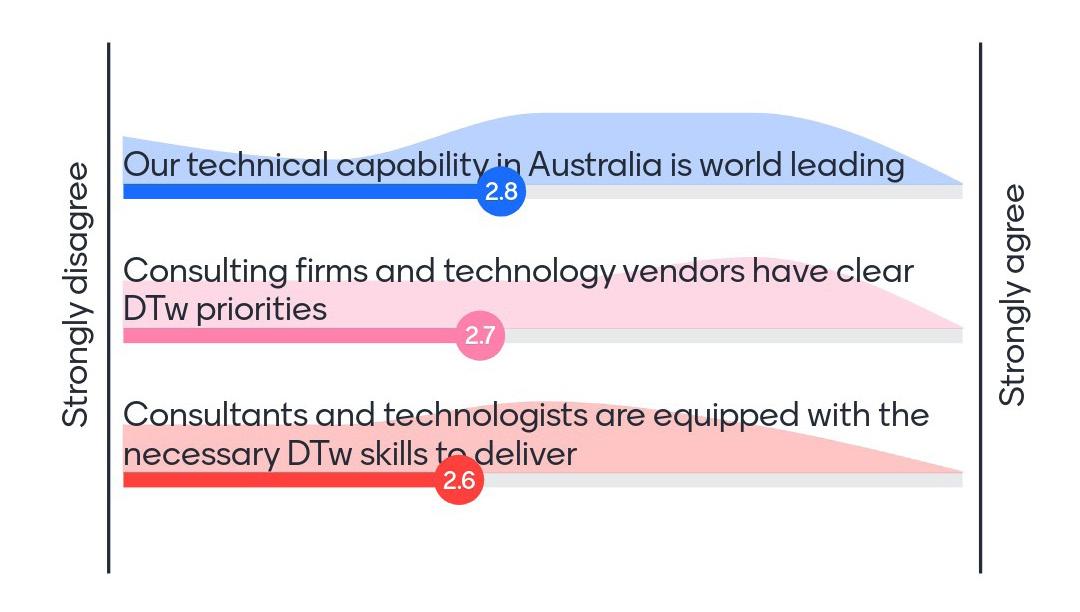
1. business capability
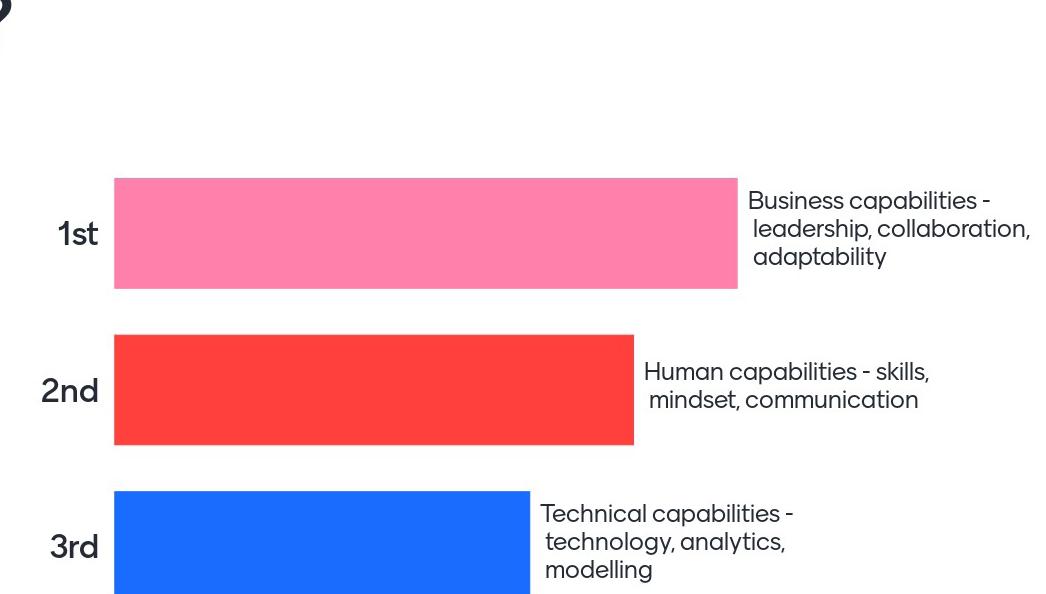
2. human capability
3. technical capability.
To unlock the opportunity of DTw nationally, and in order for Australia to lead on this agenda, capability must be at the centre.
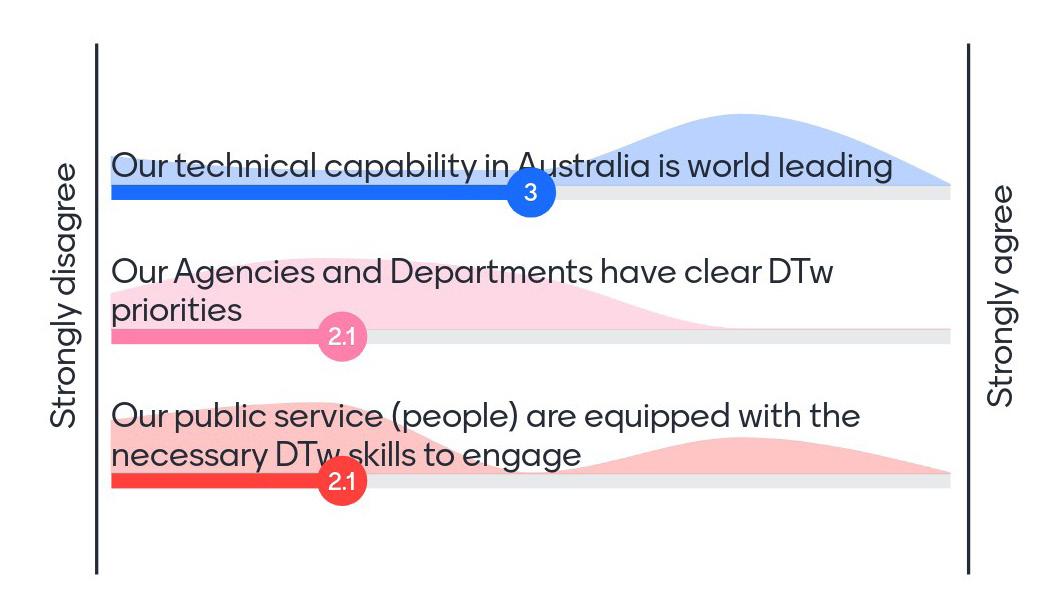
What are the most important DTw capability categories?
How would you score our current capability (for government)?
How would you score our current capability (for the private sector)?
Where could DTw standards most help?
5.4 But What Else?
As much as there is significant effort underway nationally and internationally on DTw advancement, it remains a challenging environment for any sector and any nation to truly thrive.
Internationally there is standardisation work through ISO and IEC that is bringing much needed harmonisation to key components of DTw, such as definition, benefits and maturity.
To go further and state that international harmonisation more broadly is occurring, would be unconvincing.
In Australia the situation is not much better. While great efforts exist in parts of the private sector (eg. oil, gas and mining) and government (eg. VIC Government, NSW Government), there is little harmonisation, consistency or coordinated strategy to unlock the value of DTw capability for the nation.
To help frame a series of recommendations, the following elements have been used:
• Leadership and governance
• Enablers, such as standards, capability and technology
• A national pilot program to test the opportunity and further understand the benefits
These are further discussed in the next section.
6. Next - Recommendations for market leadership
6.1 Navigating Next
To help move beyond the current level of fragmentation, and to overcome the likely barriers to being a national and global leader, the following three key problem statements have been framed through research and stakeholder engagement.
These include:
1. There is no current national leadership and governance or strategic plan for DTw success
2. The current development of DTw standards (for Australia) relies predominantly on international efforts
3. There is a struggling marketplace that is uncertain of how to mobilise (early action and investment)
Recommendations responding to each of these have been developed in the following pages, and are under three categories:
Standards
Governance/Working Group
Capability
Technology Investments
National Strategy
LEADERSHIP & GOVERNANCE
THE ENABLERS ACTIVATING
6.2 Leadership And Governance
To be effective nationally, and position itself as a global leader in DTw, Australia must put in place a number of leadership and governance arrangements.
The foundational leadership and governance recommendations are to:
• Identify an Australian Government Sponsor for DTw
• Establish a governance body and industry working group
• Develop a National DTw Strategy
National DTw Sponsor
In an emerging market where both policy and practice is yet to fully mature, government leadership is critical to build early catalytic action.
Whether it be the development of a sector strategy or other guidance document, pilot programs or grant funding for early innovators, such actions are best delivered by government entities. But above all, government leadership and a framework for DTw implementation facilitates accountability and continual performance improvement.
But the critical question is, for a cross-cutting and multi-sector opportunity like DTw, who should lead?
Australia is yet to formally nominate and establish a national DTw ‘sponsor’ whose role is to stimulate this early market activity and guide opportunity for the nation. However there has been early signs from the likes of Infrastructure Australia, ANZLIC and Geoscience Australia that DTw capability is of critical importance to the nation’s ability to generate value from data.
For Australia to realise the aspiration of national and international DTw leadership, it is essential a sponsor be identified, comprising a relevant Minister or senior bureaucrat and a department or portfolio that can drive impact.
Governance Body and Industry Working Group
To support the decisions and actions of the national sponsor, a governance body and industry working group should be established.
The Australian Government has multiple opportunities to establish a governance body or build off existing efforts that are already in place.
For example, the Digital and Data Ministers Meeting is a forum to establish proposals for better cross-government collaboration on data and digital transformation to drive smarter service delivery and improved policy outcomes.
Hosted by the Department of Industry, Science and Resources, ANZLIC (The Spatial Information Council) is another governance entity that exists, albeit with little funding.
Infrastructure Australia is another potential government entity that could support a national sponsor.
A governance entity should be established and an industry working group appointed to support the national DTw sponsor. An existing governance entity/forum or newly created one should follow the sponsor’s appointment.
In the United Kingdom, the Centre for Digital Built Britain was created to fulfil the role of governance body and industry working group combined and was a partnership between the UK Government and Cambridge University. This partnership led to a funded program of engagement and knowledge exchange, standards development and capacity building across multiple sectors, uplifting the UK marketplace and positioning it as a global leader.
National DTw Strategy
The development of a National DTw Strategy should be stewarded by the Australian government via the sponsor and Industry Working Group. This document would focus on the goal of identifying the actions and investments to help catalyse a DTw marketplace for Australia.
The Strategy would be considered a foundation for subsequent work by other levels of government, industry and academia to build off.
The Strategy should articulate a suite of goals, priorities and recommendations to help realise the value of DTw capability across multiple sectors and geographies, and identity opportunities for building strong demand for DTw capability, and supply side organisations that can support the delivery of best DTw solutions and support.
One focus for the Strategy should be to help shape DTw standards, technical and strategic guidance materials and policy and programs to activate the DTw market.
The Strategy would be used as a critical enabler for market transformation and leadership by helping:
• Policy makers shape their policy making, program design and support
• Practitioners and advisors align their advice and support to clients
• Vendors align their products and services, and their evolving innovations
• Academics identify research opportunities, in particular the necessary longitudinal studies to help build the business case and value proposition
• Asset owners and operators seek opportunities to improve performance and direct investments.
6.3 Standards, Capability and Technology
Following the establishment of the leadership and governance arrangements there are a range of key enabling activities that need to be advanced, which are focused on:
• Creating a standards -led environment for policy makers and practitioners
• Enhancing the nation’s capability to advance DTw opportunities
• Investing in emerging DTw technology
Standards
A DTw Standards Roadmap should be developed to help identify current and future standards that are required to deliver on the vision of a national DTw program. Mapping current ISO/IEC standards would be an important part of this process, understanding the scope and timing of ISO/IEC 30173 (Concepts and Terminology) which is scheduled to be published in 2024 and ISO/IEC 30172 (Use Cases) scheduled for publication in 2024 also.
As well as the ISO/IEC standards currently under development, it will be necessary to understand future ISO/IEC standards that are emerging, such as DTw Maturity (2025) and DTw Reference Architecture (2025).
The Roadmap would then recommend Australian Standards that would help support a national DTw program, which may include for example:
At a ‘strategic’ level:
• DTw Business Case - applications, asset lifecycle scope
• DTw Strategy - similar to ISO/AS 37106
At a ‘process’ level:
• Data Architecture and Activation - (based on core capabilities) reference architecture
• Data Management and Assurance - Data Sources and Structure and Quality
• Decision making with DTws
At a technical level:
• DTw Interoperability
• Privacy and Security for DTws
DTw strategies, roadmaps and business cases are being procured by government across Australia right now. Private sector consultants and advisors and technology vendors are offering services and solutions to match this early demand. However, there are no DTw standards available to the marketplace that really address this issue. This is a concern for government, industry and the community alike.
With no standards, common approach or benchmark on what good looks like for DTw, realising the full potential of DTw capability to infrastructure and service delivery could be compromised.
While the development of key international standards for DTw is underway, with the first ones anticipated to the published within the next 18-24 months, there was a sense of urgency expressed during the stakeholder engagement process that at least some consistent definitional language and approach is required now.
It is recommended that a strategic DTw standard is urgently developed and published to enable a consistent approach to strategy development and business case planning as a minimum.
This would support the DTw mobilisation efforts across multiple sectors that seems to be increasing, particularly for local and state and territory governments.
Australia’s leading representative bodies in digital, data and built and natural environments should be convened by Standards Australia to prepare this strategic document, which offers definition, scope and process-related guidance to the marketplace. This would include organisations such as The Internet of Things Alliance Australia, the DTw Partnership, the Australian Sustainable Built Environment Council, SSSI and others.
This standard (or guidance document) should include as a mimumum guidance to develop a DTw road map, strategy, and other components, including:
• Clear strategic assessment of the application of a DTw
• Producing a strategic business case
• Providing a delivery strategy
• Producing a full business case
• Developing a detailed implementation and procurement plan.
Incorporating this DTw guidance into a standard or similar document would position Australia as an international leader in this element of capability development.
Capability
During the stakeholder engagement process associated with the development of this white paper capability was identified as a critical enabler for building the nations leadership and impact in DTw. The figure on the next page identifies just some of the responses to questions, in this instance - “How would you score the current capability of government?”
Standards Australia should convene academia, government and private sector representatives to create a pathway to the creation of a Framework for DTw skills and competency for the National DTw Program.
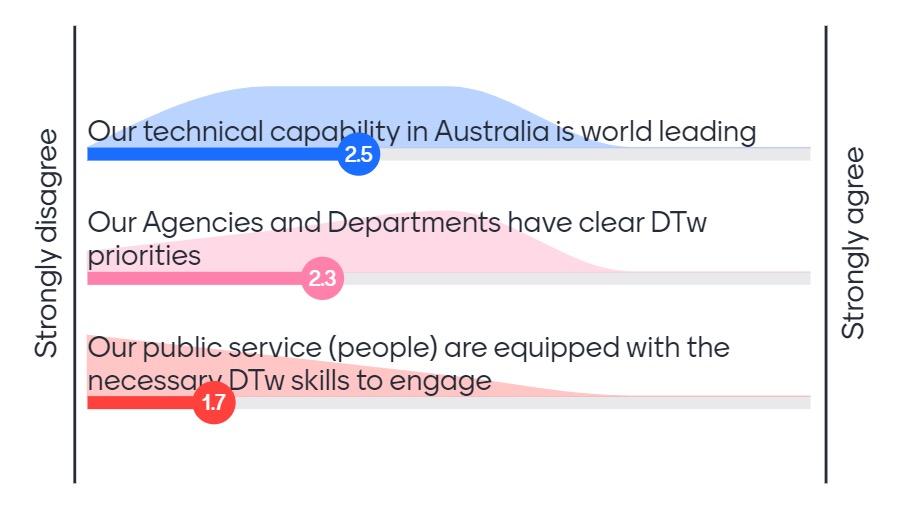
Such a framework would not only provide academia with an opportunity to create structured curricular for undergraduate and post graduate courses, but for the existing workforce to undergo continuing professional development to further its skills and create employment opportunities.
Having this Framework underpinned by relevant DTw standards will be essential to ensure the nation’s capability, capacity and innovation aligns with international activity and offers opportunity for Australia to be competitive and lead the world in DTw capability, technology and best practice.
Technology Investment
The Australian Government is committed to investing in and advancing research and development around critical technologies that help boost Australia’s competitive advantage internationally, enhance our productivity and strengthen jobs across our supply chains. Some of the technologies the government is seeking to invest in include:
• Advanced data analytics
• Artificial intelligence
• Machine learning
• Advanced communications such as 5G and 6G
• Quantum sensors
• Drones
• Satellites
• Autonomous systems operations
Each of these has a critical role to play in the suite of DTw capabilities. The strategic questions that all sectors interested in advancing DTw should be answering are:
• What is the leadership position with key technology enablers (lidar, 5g etc) that we can build off of to help build an international leadership position with DT?
• What investment/programmatic areas in technology innovation could Australia invest in to accelerate national and international DTw capability?
6.4 National DTw Pilot Program
It is recommended that the Australian Government support a national DTw pilot program to interrogate the benefits of DTw and the enabling capabilities across human, business, and technology spheres.
A dedicated proof of concept project(s) will explore the potential benefits from developing standards-based DTw models of the built and natural environment and will set out some of the challenges and security risks involved in doing so.
Deep engagement with state and territory governments, local council’s and land authorities will be critical. Standards Australia would use the program as a sandbox to not only create standardisation documents, but also identify opportunities to link siloed standards that already exist – for example smart cities, interoperability, IoT and geospatial.
Case Study: UK National DTw Programme About
The National DTw programme (NDTp) was run by the Centre for Digital Built Britain, a partnership between the University of Cambridge and the Department for Business, Energy and Industrial Strategy. Launched by HM Treasury in July 2018, the NDTp was set up to deliver key recommendations of the National Infrastructure Commission’s 2017 ‘Data for the Public Good Report’.
Key Actions
Activity focused on aligning industry and government behind a common definition and approach to information management, so that data can be shared openly and securely between future DTws. This included:
• Gemini Principles (2018), a paper setting out the proposed principles to guide the national DTw and the information management framework that will enable it;
• DFTG roadmap (2018), a prioritised plan for five core streams responsible for the delivery of the information management framework;
• DTw Hub launch (2019), a web-enabled community for early adopters of DTws to learn through sharing and progress by doing;
• Flourishing Systems (2020), a paper advocating a shift in vision for infrastructure that is peoplefocused and system-based.
• Pathway towards an IMF (2020), a technical paper and a summary paper on the proposed technical core for the information management framework.
• Gemini Programme (2020), this programme enabled the development of resources for the DT Hub community to expand the reach of the Information Management Framework and the NDTp. The Gemini programme brought together people and organisations who volunteered their time and resources to develop materials for use by the DT Hub community.
What’s Next
Centre for Digital Built Britain completed its five-year mission and closed its doors at the end of September 2022.
7. Appendices
A- Stakeholder Organisations Consulted
Individuals representing the following organisations participated in the survey associated with this white paper.
Bennett + Bennett Group
Bob Co
British Standards Institution
City of Perth
City of Port Phillip
City of Yarra
CoDigital
Department for Infrastructure & Transport dRofus formerly Centre for Digital Built Britain
FrontierSI
Greater Cities Commission
GHD
GWI
Honeywell
Hurley Development
KPMG Australia
LivePerson Inc
McConnell Dowell
Mott MacDonald nbs
ParKam
RMIT University
SMEC
Spacesium
Town of Bassendean
Transport for NSW
V/Line Corporation
Wellington city council
Willow Inc
Wipro Technologies
Women in BIM
B - References and Further Information
1. https://www.csiro.au/en/news/news-releases/2018/australias-315bn-opportunity
2. https://www.industry.gov.au/publications/australias-artificial-intelligence-action-plan
3. https://www.letsbuild.com/blog/a-history-of-bim
4. https://www.statedevelopment.qld.gov.au/industry/infrastructure/infrastructure-planningand-policy/building-information-modelling
5. http://www.opv.vic.gov.au/Digital-Build/Victorian-Digital-Asset-Strategy
6. https://www.transport.nsw.gov.au/digital-engineering/digital-engineering-framework-0
7. https://www.abab.net.au/
8. https://www.an z lic.gov.au/resources/principles-spatially-enabled-digital-twins-built-andnatural-environment-australia
9. https://www.digital.nsw.gov.au/policy/internet-of-things#:~:text=NSW%20Government’s%20 Internet%20of%20Things%20Policy&text=encourage%20innovation%20with%20Internet%20 of,Internet%20of%20Things%2Denabled%20solutions.
10. https://www.acs.org.au/insightsandpublications/reports-publications/securing-the-internetof-things-for-a-smart-city.html


